Physical Address
304 North Cardinal St.
Dorchester Center, MA 02124
Branchial cleft anomalies
Thyroglossal duct cyst
Cervical thymic cyst
Bronchogenic cyst
Dermoid cyst
Others
Bacterial and mycobacterial
Fungal
Viral
Protozoal
Sarcoidosis
Others
Mesenchymal lesions
Others
Cystic lesions of the neck represent a diverse group of lesions listed in Box 12-2 .
Definition: Congenital malformations related to the branchial apparatus.
Branchial apparatus appears around the fourth week of gestation and consists of a paired series of six arches, five pouches, and five clefts or grooves.
Embryologic development of the head and neck structures can be classified through the development of the branchial apparatus, including arches (mesoderm), clefts (ectoderm), and pharyngeal pouches (endoderm) ( Table 12-1 ).
| Arches (Mesoderm) | Pharyngeal Pouches (Endoderm) | Clefts (Ectoderm) | |
|---|---|---|---|
| First |
|
Epithelial lining of the middle ear cavity, inner part of the tympanic membrane, eustachian tube, mastoid air cells | Epithelial lining of the external auditory canal, and outer part of the tympanic membrane |
| Second |
|
Epithelial lining of the tonsillar fossa and palatine tonsil | None |
| Third |
|
Inferior parathyroid glands, thymus, pyriform sinus | None |
| Fourth |
|
Superior parathyroid glands C-cells of ultimobranchial body |
None |
| Fifth and sixth |
|
C-cells of ultimobranchial body (5th pharyngeal pouch) 6th pharyngeal pouch: none |
None |
Branchial apparatus gives rise to most of the important structures of the head and neck, including the face, oral cavity, ears, and neck.
No gender predilection; occur at any age, but most commonly become evident in young adults
Predominantly occur in the lateral neck along the anterior portion of the sternocleidomastoid muscle:
Also seen in the area around the external ear, in the external auditory canal, and in the parotid gland
Generally, occur as an isolated phenomenon but may be familial or may rarely be associated with other congenital defects, including:
Malformed auricles
Hearing abnormalities
Patent ductus arteriosus
Tear duct atresia
Branchial cleft anomalies are divided according to the branchial apparatus involved and are further divided into cysts, sinuses, or fistulas:
Cysts are epithelial-lined structures that may occur as an isolated lesion or may occur in association with a sinus or fistula.
Sinuses are tracts with a single opening; the opening may be to skin, representing a branchial cleft or ectodermally derived sinus tract (cutaneous sinus tract), or to mucosa, representing a branchial pouch or endodermally derived sinus tract (mucosal sinus tract).
Fistulas are tracts with two openings, which can be cutaneous or mucosal.
Cysts present as nontender, fluctuant masses in appropriate locations; cysts may become inflamed and abscesses may develop, potentially associated with dysphagia, dyspnea, or stridor.
Sinuses and fistulas are associated with discharge of mucoid and/or purulent secretions from the tract opening.
Up to 10% of cases may be bilateral.
Histogenesis of branchial cleft anomalies is controversial:
Among the structures proposed as the origins for these anomalies include the branchial apparatus (considered to represent the origin for these abnormalities), salivary gland inclusions, and thymic duct.
In comparison to second branchial anomalies, first branchial anomalies are uncommon, representing from 1% to 8% of all branchial apparatus defects.
Typically occur in the area of the external ear and may include cysts, sinuses, and fistulas.
First branchial anomalies may be identified in a variety of locations, including pre-, post-, or infra-auricular, at the angle of the jaw, associated with the earlobe, and in the external auditory canal or involving the parotid gland.
Involvement of the external auditory canal may result in otalgia or otorrhea.
Parotid involvement may result in an intra- or periparotid mass that may be mistaken for a parotid gland tumor.
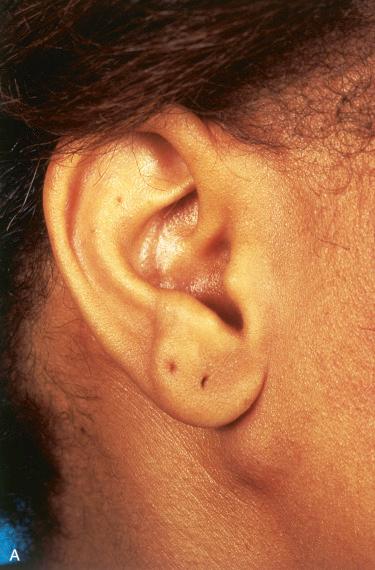
Majority of first BA are cysts, representing more than two thirds (68%) of these anomalies:
Appear as solitary cystic lesions without an associated sinus tract
Sinuses and fistulas equally make up the remainder of these lesions:
Fistula tract in first branchial anomalies may extend from the skin over or through the parotid and open in the external auditory canal.
Microscopic
First branchial lesions can be divided into two types as defined by Work, which are referred to as type I and type II lesions:
Type I:
Contains only ectodermal elements, including keratinizing squamous epithelium without adnexal structures (i.e., hair follicles, sebaceous glands, sweat glands) or cartilage, thereby duplicating the membranous external auditory canal
Represents a first cleft anomaly only
Typically are located medial, inferior, or posterior to the concha and pinna
Sinuses parallel the external auditory canal and end in a blind sac at the level of the mesotympanum.
External auditory canal is intact and hearing is normal.
Type II:
Have ectodermal and mesodermal elements, including keratinized squamous epithelium, cutaneous adnexa, and cartilage, thereby duplicating the external auditory canal and pinna
Typically localize to a point just below the angle of the mandible
Sinus or fistula tracts extend upward over the angle of the mandible through the parotid gland toward the external auditory canal.
Type II anomalies are more intimately associated with the parotid gland than type I anomalies, although parotid tissue may be found in association with type I sinus or fistula tracts.
Tracts associated with type II defects may terminate short of the external auditory canal or may open up in the external auditory canal near the junction of the cartilaginous portion and osseous portion of the canal; communication with the middle ear is uncommon.
For either type I or type II defects, an associated prominent lymphoid component is not usually present, contrasting with second BA; only when inflamed or infected will there be an associated lymphoid component.
Some authorities recommend that, due to the overlapping histology between Work types I and II, all first branchial cleft anomalies be classified only as cysts, sinuses, or fistulas.
Unless inflamed, a prominent lymphoid component is not seen, contrasting to the findings that can be seen in second branchial cysts.
Epidermoid cyst
Dermoid cyst
Regardless of the histology, complete surgical excision is the preferred treatment:
Inadequate excision results in recurrence and increased risk of infection.
Incision and drainage are indicated in cases in which abscesses have developed, and in this situation complete surgical excision must wait until resolution of the infection.
Type II anomalies are often intimately associated with the parotid gland, necessitating a superficial parotidectomy to ensure complete excision.
Although there is no consistent relationship between the tract and the facial nerve as it courses through the parotid gland, exposure and dissection of the nerve and its branches are required in Work type II anomalies.
Synonym: Second branchial cysts also referred to as (cervical) lymphoepithelial cyst
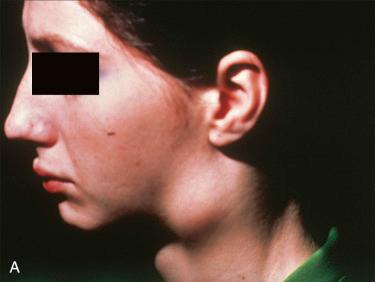
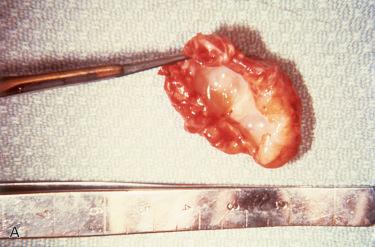
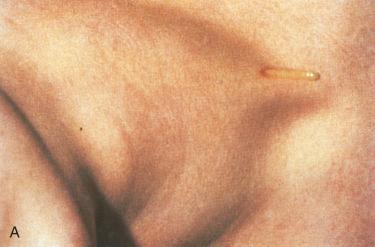
Accounts for the majority of the branchial apparatus anomalies, representing from 92% to 99% of all cases
Equal gender predilection; typically occurs in the third through fifth decades of life:
Uncommon in patients older than 50 years of age:
Less than 3% of cysts present after the age of 50
Lateral neck cysts in patients 50 years of age and older should prompt diagnostic consideration for a metastatic cystic squamous cell carcinoma (see Chapter 13 ).
Occur along the anterior border of the sternocleidomastoid muscle; most common at the level of the angle of the mandible
Present as a painless, fluctuant neck mass that may increase in size in the face of an upper respiratory tract infection, at which time they may become painful
Cysts are much more common than fistulas.
Sinuses and fistulas are most often identified at birth or in early childhood, presenting as a small opening above the clavicle through which mucoid secretions may be expressed; these are divided into three types:
Incomplete external, with an external (cutaneous) but no internal (pharyngeal) opening
Incomplete internal, with a pharyngeal but no cutaneous opening
Complete, with pharyngeal and cutaneous openings:
The cutaneous opening is seen anywhere along the anterior border of the sternocleidomastoid muscle from the hyoid bone to the sternum, with the epithelial tract coursing cephalad, between the internal and external carotid arteries, over cranial nerves IX and XII, deep to the posterior belly of the digastric muscle and terminating close to the middle constrictor muscle or with an internal opening in the pharyngeal wall and/or tonsillar region.
Radiology:
Cysts appear as well-defined, low-density lesions surrounded by a thin, uniform wall.
Noninflamed cysts have no or minimal CT mural enhancement.
Infected cysts have increased CT density of the central fluid with rim enhancement and poorly defined cyst wall.
Fistulas or sinus tracts may extend either toward the skin surface, supratonsillar fossa, as well as between the internal and external carotid arteries.
Histogenesis of second branchial cleft cysts is controversial:
Among the structures proposed as the origins for these anomalies include the branchial apparatus (considered to represent the origin for these abnormalities), salivary gland inclusions, and thymic duct.
Cysts are thin-walled cystic structures filled with cheesy material or serous, mucoid, or purulent fluid; nodular excrescences may be seen lining the cyst wall.
Cyst lining epithelium is predominantly a stratified squamous epithelium seen in approximately 90% of cases; less frequently a purely columnar epithelial lining or a mixed lining may be seen.
Cyst wall typically contains a nodular or diffuse lymphoid infiltrate often with germinal centers.
Fibrosis and granulation tissue may be prominent and even replace the surface epithelium in cases associated with repeated infections.
Fistulas often are composed of a stratified squamous epithelium associated with the external segments and a columnar epithelium with the internal segments.
There is no evidence of thymic (thymic cyst) or thyroid tissue (thyroglossal duct cyst).
Cytokeratin(s) positive
p16 negative:
Branchial cleft cysts can exhibit focal patchy weak to strong reactivity limited to the superficial squamous epithelium.
Absence of p16 may be helpful in distinguishing branchial cleft cyst from metastatic oropharyngeal nonkeratinizing squamous cell carcinoma but it is not as useful in cases of metastatic keratinizing squamous cell carcinoma as the latter are typically p16 negative.
Thyroglobulin, TTF1, PAX8 negative
Low proliferation rate (less than 5%) by Ki67 (MIB1) staining
Thymic cyst
Thyroglossal duct cyst
Metastatic cystic squamous cell carcinoma, including HPV-associated and non-HPV-associated:
Absence of cytologic features of malignancy excludes the diagnosis of a metastatic cystic squamous cell carcinoma
Some examples of cystic metastatic squamous cell carcinoma may be composed of relatively bland cytomorphologic features but even in such cases there are foci of cytologically atypical/malignant epithelial cells characterized by pleomorphic nuclei and increased mitotic activity:
Increased proliferation rate as determined by Ki67 (MIB1) staining would be present in metastatic carcinoma and absent in branchial cyst.
Diffuse and strong (nuclear and cytoplasmic) p16 immunoreactivity, representing a surrogate marker for HPV-16, would confirm the diagnosis of metastatic cystic HPV-associated carcinoma of oropharyngeal origin, differentiating it from a branchial cleft cyst, which should be nonreactive for p16.
p16 may be overexpressed in almost 50% of benign branchial cleft cysts potentially limiting the diagnostic utility of p16 in this setting; in such an occurrence molecular testing (in situ hybridization, PCR) would be necessary to confirm presence of HPV and the malignant nature of the cyst.
Confusion and controversy exist between the diagnosis of metastatic cystic squamous cell carcinoma and that of a carcinoma arising in a branchial cleft cyst (so-called branchial cleft carcinoma or branchiogenic carcinoma); criteria for the diagnosis of a branchiogenic carcinoma include:
The tumor occurs along the line extending from a point anterior to the tragus along the anterior border of the sternocleidomastoid muscle to the clavicle.
Histology supports origin from a branchial cleft-derived structure (i.e., situated in the lateral aspect of the neck).
Histology supports carcinoma arising in the wall of an epithelial-lined cyst.
A minimum of 5-year follow-up demonstrates no evidence of a primary source for this neoplasm.
Despite the fulfillment of these criteria, it is highly unlikely that carcinoma arises in a branchial cleft cyst; rather, these cystic squamous cell carcinomas take origin from a primary tumor in Waldeyer tonsillar ring:
Primary (Waldeyer ring) neoplasm may be so small as to defy clinical detection but nevertheless is capable of metastasizing.
Histology demonstrates partial or complete replacement of the lymph node by an epithelial-lined structure with central cystic change; the epithelium varies from areas that are bland, composed of uniform cells lacking pleomorphism, crowding, or loss of polarity, to overtly malignant-appearing epithelium composed of pleomorphic cells with increased cellularity, mitoses, and a loss of polarity.
Metastatic papillary thyroid carcinoma:
Absence of architectural and cytomorphologic features associated with papillary thyroid carcinoma would differentiate metastatic papillary thyroid carcinoma from second BA.
Cystic metastatic papillary thyroid carcinoma to the neck may occur in the absence of a known history of a primary thyroid carcinoma and/or as an occult metastasis. Further, the primary thyroid-based carcinoma may be very small and clinically difficult to detect. Most often the metastasis originates from the ipsilateral thyroid lobe. Given the clinical scenario of unsuspected/unknown primary thyroid carcinoma, the histology of the neck mass may include a flattened/attenuated epithelial lining without papillary architecture histologically simulating the appearance of a branchial cleft cyst:
Attention to the nuclear features may alert the pathologist to the possible presence of metastatic papillary thyroid carcinoma.
In suspect cases, thyroglobulin, thyroid transcription factor 1 (TTF-1), and PAX8 reactivity would be present in metastatic papillary thyroid carcinoma and absent in BAs:
Thyroglobulin reactivity is the single best marker for lesions of thyroid follicular epithelial cell origin and is generally absent in all other (nonfollicular epithelial cell origin) lesions.
TTF-1 reactivity is not unique for follicular epithelial-derived lesions of the thyroid but can be present in other lesion types, including (but not limited to) medullary thyroid carcinoma and pulmonary adenocarcinoma; in contrast, thyroglobulin reactivity is a dedicated marker for lesions of thyroid follicular epithelial cell origin and represents the preferred immunomarkers in the evaluation for metastatic carcinomas of thyroid follicular epithelial cell origin.
Regardless of the histologic (nuclear) features, thyroid tissue located in lymph nodes situated lateral to the great neck vessels represents metastatic thyroid carcinoma; see Section 8, Thyroid Gland, for more complete discussion.
Complete surgical excision is the preferred treatment.
Depending on the extent of the fistula tract, a tonsillectomy may be needed.
Third BAs are rare.
May present as recurrent neck abscesses associated with stridor or as recurrent episodes of acute suppurative unilateral thyroiditis
A sinus or fistula open externally anterior to the lower third of the sternocleidomastoid muscle:
If complete, the internal opening of the sinus or fistula is in the piriform sinus following passage of the tract along the carotid sheath penetrating the thyrohyoid membrane cranial to the superior laryngeal nerve.
Cysts occur anywhere along the sinus tract but are most commonly found in the region of the laryngeal ventricle or in the anteroinferior cervical triangle.
Cysts are lined by a stratified squamous epithelium or ciliated epithelium; an associated marked lymphocytic cell infiltrate may be present.
Thymic tissue, derived from the third branchial cleft pouch, may or may not be present.
Complete surgical resection of a third BA (cyst, sinus, fistula) is the preferred treatment and is necessary to prevent recurrence:
Surgical procedure may require a subtotal thyroidectomy.
Fourth BAs are extremely rare.
The majority of patients presents before the age of 20 years.
Clinical manifestations of fourth BAs are similar to those of third BAs, including recurrent neck abscesses or recurrent episodes of acute suppurative unilateral thyroiditis.
Almost all fourth BAs are sinuses that may originate from the piriform sinus:
The sinus tract usually has an internal opening at the apex of the piriform sinus caudal to the superior laryngeal nerve, descends translaryngeally beneath the thyroid cartilage, exiting the larynx near the cricothyroid joint below the inferior constrictor muscle, and then continues superficial to the recurrent laryngeal nerve ending in the paratracheal region or in the thyroid gland.
Like third BAs, fourth BAs may or may not include thymic tissue.
Complete surgical resection of a fourth BA is the preferred treatment and is necessary to prevent recurrence:
Surgical procedure may require a subtotal thyroidectomy.
Definition: Persistence and cystic dilatation of the thyroglossal duct in the midline of the neck.
The thyroid gland is the first endocrine gland to appear during embryonic development.
Thyroid gland derives from three primordium, the median anlage, and lateral anlages:
Median anlage develops around the 24th day of gestation as a small, median endodermal thickening on the primitive pharynx; this thickening forms a diverticulum, which is attached to the tongue by a narrow tube, the thyroglossal duct; its opening in the base of the tongue constitutes the foramen cecum.
Proximal opening persists as the foramen cecum of the tongue
As a result of further cellular proliferations, the hollow thyroid diverticulum obliterates and divides into the right and left lobes, connected by the isthmus around the seventh week of gestation.
During development the thyroid descends and assumes a definitive position in the anterior neck; by this time the thyroglossal duct degenerates.
See Section 8, Thyroid Gland, for a more complete discussion including illustrations.
Majority of cases occurs in the midline of the neck above the thyroid isthmus but below the level of the hyoid bone:
Thyroglossal duct cysts are nearly always connected to the hyoid bone.
Uncommonly, thyroglossal duct cysts may occur lateral to midline but do not occur in the lateral portion of the neck (i.e., lateral to the jugular vein).
Clinical presentation of an uninfected thyroglossal duct cyst is usually that of an asymptomatic midline neck mass:
Mass typically moves upward on swallowing.
Inflamed or infected thyroglossal duct cysts may be associated with tenderness and pain.
Extrinsic airway compression in neonates with apnea, cyanosis, and respiratory compromise may uncommonly occur.
Thyroglossal duct cysts are smooth-walled, cystic structures that usually measure less than 2 cm.
In noninflamed cysts, the cyst lining is respiratory (columnar) epithelium but may also include squamous epithelium.
Presence of thyroid tissue in the cyst wall varies and may be dependent on the extent of specimen sampling; in generally, thyroid tissue can be found in more than 60% of the cases.
Thyroid tissue may be normal, hyperplastic, and nodular or neoplastic (see below).
Surgery is the preferred treatment; en bloc surgical resection of the cyst, the middle third of the hyoid bone (Sistrunk procedure), and the suprahyoid tract up to the foramen cecum; this extended surgery prevents recurrence:
Adequate surgery results in cure with low, if any, recurrences.
Benign and malignant neoplasms may occur in the setting of a thyroglossal duct cyst.
C-cell–related lesions, including medullary carcinoma, do not occur in thyroglossal duct cysts due to the different embryologic derivation of the C-cells.
Definition: Cervical thymic tissue sequestered from the main thymic gland during its embryologic descent:
Sequestered thymic tissue may be solid (so-called accessory cervical thymic tissue) or cystic (cervical thymic cyst).
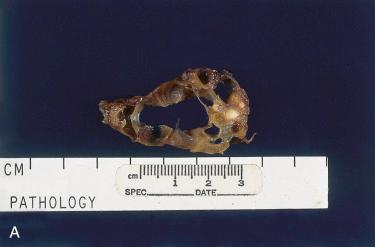
Thymus develops in the sixth week of gestation, arising primarily from the third branchial pouch (mesoderm); the fourth branchial pouch may provide minimal contribution to the development of the thymus.
Thymic primordia descend in the neck along the course of the carotid sheath.
Connection of the paired primordia to the pharynx is retained by the thymopharyngeal ducts.
During the eighth week of gestation the thymic primordia fuse in the midline of the neck and then descend into the mediastinum.
Failure of descent or failure to involute results in thymic abnormalities, including cervical thymic cyst.
Cervical thymic cysts are considered to be congenital, although mediastinal thymic cysts are thought to be acquired.
Cervical thymic cysts are uncommon.
Occur slightly more often in men; the majority of cervical thymic cysts (67%) occurs during the first decade of life with the rest occurring in the second to third decades:
Rarely, cervical thymic cysts occur in adults.
Found anywhere between the angle of the mandible and the sternum, including the lateral and midline neck
Majority of patients presents with a slow-growing, painless neck mass that may transiently increase in size during a Valsalva movement; uncommonly, the clinical presentation may include dyspnea, dysphagia, hoarseness, or pain.
Rarely (if ever) associated with a sinus or fistula
May represent an isolated cystic lesion in the neck, may extend into the mediastinum, or may be in continuity with an intrathoracic thymus gland:
Radiology:
Connections to intrathoracic structures result in abnormal radiologic findings.
Appearance of cervical thymic cyst on CT can be characteristic:
The course of the descent of embryologic thymic tissue in the neck to the mediastinum indicates the potential site of deposition of an ectopic cervical thymic cyst.
In a child, a cystic lesion that has an intimate relationship to the carotid sheath is likely to be a thymic cyst.
Cysts are unilocular or multilocular, usually contain clear, serous-appearing fluid, and may measure up to 15 cm in greatest dimension.
Cyst wall lining is smooth or trabeculated; the cyst wall varies in thickness.
Become a Clinical Tree membership for Full access and enjoy Unlimited articles
If you are a member. Log in here